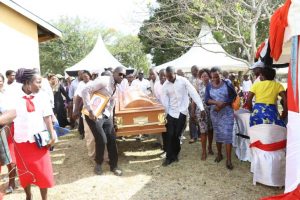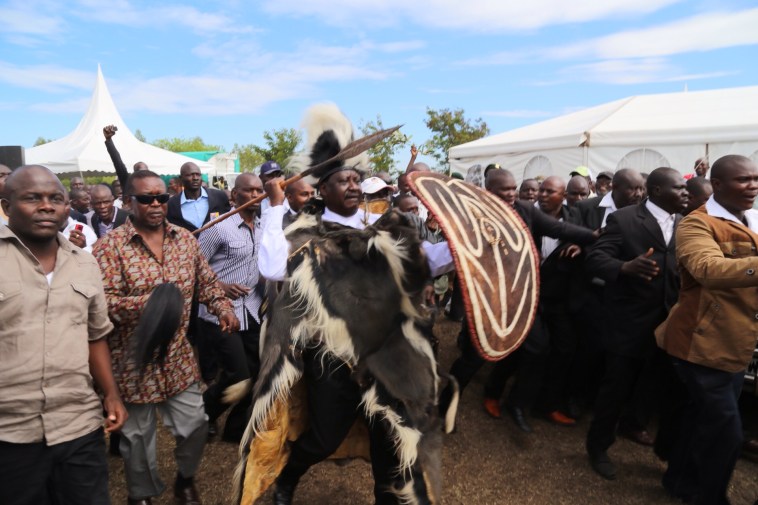Luos from all over Africa respect and revere the dead and have many funeral or burial rites which must be fulfilled over a period of one year. To the current generation who are ignorant, today we help you learn about these rites.
1. Death Announcement ~ Lendo
While death would be announced early in the morning, risk of the news leaking has forced the community nowadays to announce the death at any given time. Death of older members of the society would be announced after sunset.
The community has adopted new media and even radio and TV announcements nowadays with many relatives not getting news directly from family members but through social and mainstream media.
2. Vigil ~ Budho
After the announcement of death, a vigil or budho is announced with clear guidelines on where it will be. In the village, it’s always at the homestead of the deceased or if he or she was still in the home of the parents, they’ll be having the vigil at the house of parents.
Vigil for sisters-in-law would be held in the husband’s house or a new one would be built if the husband had not built. The house would be called simba and taken as that of an unmarried man as the husband delayed building a house for the wife. After the burial, the husband would have to bring down the old house and build another which will now be considered house of the married.
Close relatives of the deceased would be required to stay around and keep the immediate family members company. Neighbours would join in and help observe the vigil until a few days after burial. Mourners would wait for relatives staying in the cities. Cousins would be required not to leave the home.
Men would make a bonfire called magenga near the house for warmth.
3. Digging the Grave ~ Kunyo Bur
Digging grave for burying the dead was done at night but it has been changed to daytime as current generation of young men abused the ritual and started demanding alcohol from the bereaved.
Gravedigging would be a men-only affair with local brews like Changaa and busaa openly consumed and shared among the diggers. The gravedigging would commence after 8PM and end before 4AM. One senior elder from the bereaved would supervise the digging and ensure that measurements of the coffin would fit in.
4. Burial ~ iko
Burial of deceased adults would not be done before 2 pm or after 5 pm. Speeches during the ceremony would be conducted in order of seniority and only the deceased spouse or parents left to give the last speech.
Harambee would be conducted and the dug grave would be prayed for in readiness for the short graveside ceremony.
Leaders from the area would also be allowed to give teachings, announcements and messages for the mourners before the body is lowered to the grave.
5. Escorting the Spirits ~ Tero Buru
The spirits of the dead would be escorted from the deceased homestead by men. Mourners would take cattle to the homestead of the dead early in the morning (between 6 am and 7 am) and prepare for the journey.
A cock or hen would be killed without using a knife and meat shared between the male members who form part of the mourners escorting the spirits.
Participants are men who also blow horns of buffaloes (oporo) and beat drums (bul) play drums as the cattle are driven towards the river with the dust left behind expected to symbolise the spirits of the dead being blown off.
6. Shaving ~ Liedo
After the burial and after the third day, close relatives of the dead can shave their hair off to symbolise a fresh start for mourning after the burial.
Luos believed that people must have ample time to mourn. The end of mourning is also characterised by shaving of hair of the dead again. While a razor blade was used, nowadays modern machines are used by those who still practise this.
7. Departure from Home of the Bereaved ~ Kee
The kee refers to the members of surviving family and other relatives returning to their respective homes in order of age. The eldest departs first, followed by the others until all would have departed.
It was expected that the bereaved would not be left alone in one go as the departure would be gradual. The youngest would depart last for own homes.
Part of kee meant that the eldest would also go to their homes and have sex first before others follow too.
8. Opening the Door ~ Yao Dhot
Relatives of the bereaved would arrange a time to come back to the home of the deceased and prepare to cook and share a meal with family and neighbours.The meal would be cooked by the daughters of the family (wagogni).
This would symbolise the readiness of the family to move on and welcome more blessings after the driving off of the spirits. The survivors would also be expected to start a new life and even re-marry if they lost a spouse.

9. Serving a Meal to the Deceased ~ Tedo Chai
The cooking of the tea would follow Yao Dhot and see sons and daughters of the homestead converge, contribute money and cook a meal to remember the dead parents or relatives.
Eldest son or daughter would be the first person to light the fireplace and food he or she contributed would be cooked first. Foodstuff contributed would normally include fish, maize flour, beef, sugar, beans and rice.
10. Battleground with the Spirit ~ Tero Buru Maduong’
This ritual is performed only for the death of very elderly men or those who were so influential in the society. This tero buru which literally means returning the dust is performed at a much grander scale than the previous one.
The family of the dead with women and men participating get armed with the best musical instruments and weapons as they take a huge heard of cattle to the river which is considered a battlefield.
They come back to the homestead to a bigger feast of the whole community. Relatives slaughter many heads of cattle called dher buru, and rams (Luos never ate goats) while serving local alcoholic beverage including changaa, busaa,and mbare.
They invite traditional musicians and dancers to entertain the mourners.
READ MORE:
11. Visiting the Widow’s Natal Home ~ Tero Chola
This is the ritual which ends the mourning period for the widows who were left behind. While many believed that Luos forced women to be inherited, at this point, the Luo elders expected the bereaved women to introduce the man who would take up the position of the late husband and provide for her.
If she chose a member of her husbands family, he must be younger than the late husband and mature enough to provide for her and protect her.
Widowers would also be allowed to remarry from the family with priority given to the family of the late wife to introduce a new spouse as Luos believed that in cases where children were involved, members of the late wife’s family would provide the best support for the children.
12. Dividing the Properties Left by the Deceased ~ Keyo Nyinyo
This is one of the most important occasions when the family and friends of the deceased share the simple belongings or personal effects left by the deceased. Some of the shared effects are clothes, furniture, dishes, calabashes, and cooking pots.
Fixed assets like land, vehicles and real estate together with animals are shared among sons and daughters of the deceased depending on the will. Elders sit and decide where there is no will, how to share the properties.
13. Remembrance ~ Rapar
This is one of the rituals where friends and relatives meet at the deceased’s home and remember him or her.
Food is cooked and messages of remembrance are shared. A dance is organised and activities to honour the dead are launched. Some of the activities included donating part of land to churches and schools as well as remembering neighbours who had nothing.
If the house of the deceased is gone, a small hut called akumba is built. Daughters of the deceased or homestead arrive and put their belongings in the house of the dead to symbolise their arrival.
14. Serving a Meal to the Family ~ Budho
While this was reserved for men, women also participated in remembering the dead on this day where nothing but just bonfire and stories are shared about the dead.
15. Naming ~ Chak
Considering that the mourning period took a whole year, after the end of the funeral, relatives were expected to have had sex and had babies who would now be named after the deceased.
If the deceased was male and children born were female, sometimes relatives would give the female children male names and vice versa.
This is common in Luo. That’s who some Luo men have names like Anyango and female have Onyango etc.
While this is not exhaustive, it generally guides you to understand how and why Luos took funerals seriously.


